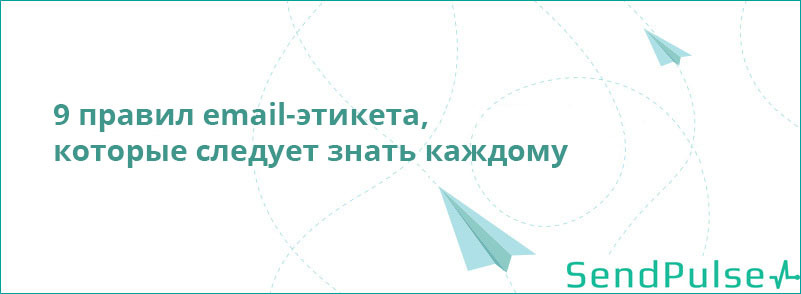9 rules of email etiquette that everyone should know

Did you know that in 2015, every second inhabitant of the planet sent and received approximately 205 billion emails of a different nature? More than half are business letters, whose number will grow by 3% each year, as expected. On average, one user sent 122 emails every day. Since the email letter remains the most efficient and used by marketers tool of communication and promotion, you need to know the basic rules of its etiquette in order not to suffer a crash when communicating with customers and partners.
Due to the fact that communication is now taking place in social networks, many etiquette rules are leveled. This can be detrimental to your business.
')
Let's consider the basic rules.
1. Letter subject
It all starts with the topic. Having seen it, the recipient decides to open the letter or not. Therefore, the topic should be clear so that the addressee understands what your letter is about.

2. Sender Mail
Send letters to clients or partners only from work mail. But if it really happened that you need to answer from a personal email, then call it correct. The recipient must understand from whom the letter came, so let it be your first and last name.
Do not use addresses that are not suitable for business correspondence. For example, "dandelion @ ...", "baby @ ..."
3. Personalization
Every person is a person. Naturally, it becomes pleasant when they contact us by name. In this way, you show respect to the person with whom you correspond.

4. The tone of the letter
When you work with your colleague for several years, an informal style of communication prevails between you. When communicating with a new potential client, the tone should be changed to a formal and respectful one.
This transformation of communication styles is also very important when writing emails. Be always aware of who your addressee is so as not to spoil the existing relationship with incorrect treatment.
Always contact only “You”, be polite and follow the official business style of communication.
5. Grammar
If you have grammatical errors in emails, you seem to directly tell the recipient that you:
- Uneducated;
- Inattentive;
- Overworked.
What can threaten a grammatical mistake? In most cases, this leads to the fact that the client acknowledges your incompetence because of an illiterate proposal. He can also conclude that you are simply not ready to work with new customers.

Spend more time checking messages for errors. Yes, you will spend more working time, but at least it will not affect the deterioration of the company's reputation and your personal in the eyes of colleagues and management.
6. Humor
It is better not to use it in business correspondence. Except if you know the interlocutor well enough.
Consider also the fact that people perceive humor in different ways. What is funny to you will not necessarily be funny to the addressee.
7. Different approach for different cultures
It is necessary to take into account cultural differences, especially in letters, when you do not see the interlocutor. Adapt emails according to recipient's cultural differences.

Let us give examples of such differences. Arabs, Chinese and Japanese want to know more about their interlocutor before they start talking about business. And the Germans and Americans, on the contrary, pay more attention to business.
8. Always respond to emails.
Try to always reply to received emails, especially if the sender is from the same industry as you. This is considered a good form and rule of etiquette in email marketing. Answer even if the letter was sent to you by mistake, but the sender is waiting for a response.
9. Send at the right time
It is very important to send letters at the right time in order for them to be read. We recommend sending your first letters with offers to partners at lunchtime from 13:00 to 14:00 or in the evening after work (18: 00-21: 00).
Business letters should exclude:
- Sarcasm or irony in expressions;
- Inappropriate humor;
- Informal language;
- Gossip or the so-called "water" (only clear facts and figures).
Bonus Tip: If you are agitated or angry, do not respond to emails immediately. Make a letter, put an end, but do not send. Take a walk: walk, breathe, go back to the workplace and look through the letter again.
And what rules of email etiquette do you use? We will be grateful if you share them with us in the comments under the article.
Source: https://habr.com/ru/post/299584/
All Articles